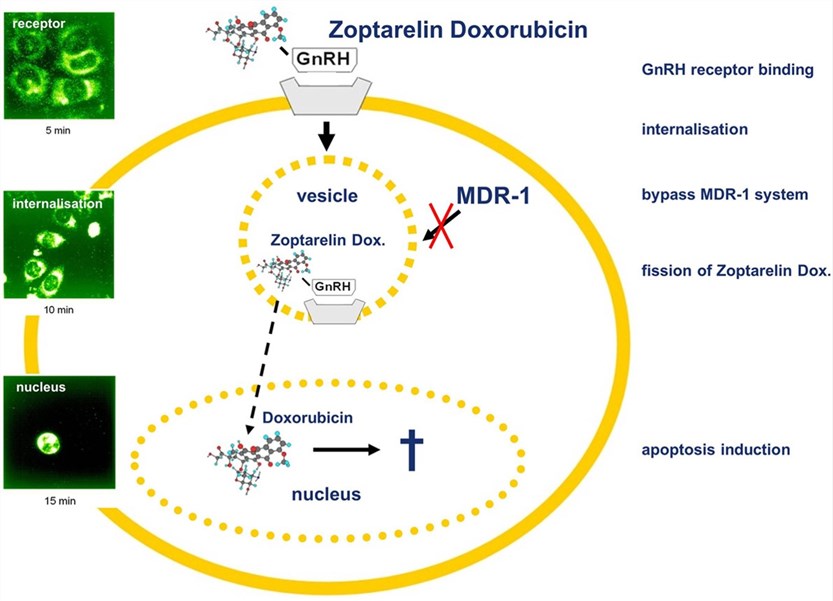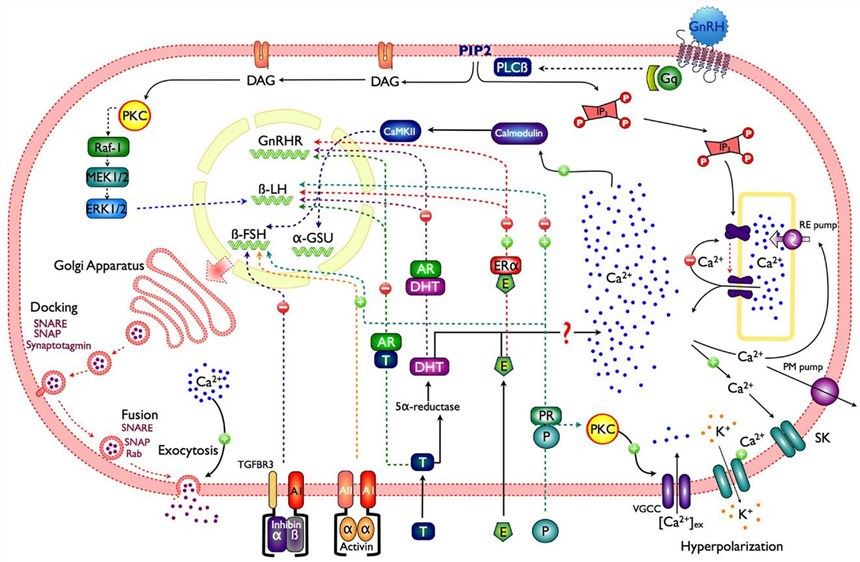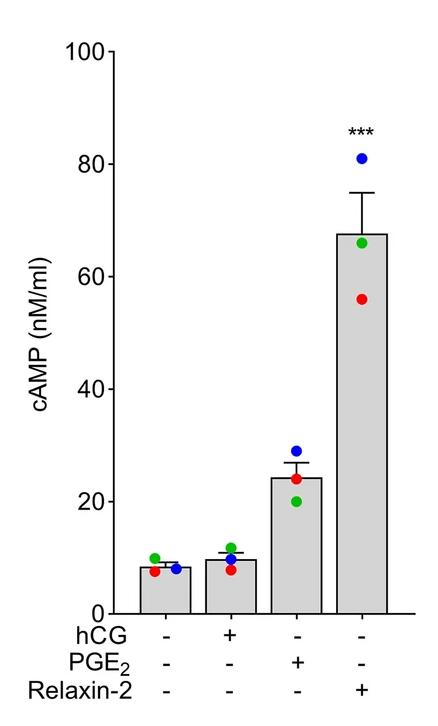Hi-Affi™ In Vitro Cell based Gonadotrophin releasing Hormone Receptor Functional Assay Service
The Importance of Gonadotrophin-releasing Hormone Receptors
The gonadotrophin-releasing hormone receptor (GnRH receptor, GnRHR) mediates the GnRH signaling pathway, which belongs to the class A G protein-coupled receptor (GPCR) family. Two homologous GnRHR have been identified: type I and type II, and they are found in a variety of organs, including the retina, gonad, certain tumor cells, etc., demonstrating that GnRH receptors exert a variety of functions. Additionally, GnRH receptors function differently in different organs. Consequently, a thorough knowledge of GnRH receptor function will aid in promoting their use as a therapeutic target in illness therapy.
 Fig.1 Gonadotropin-releasing hormone (GnRH) receptor-targeted chemotherapy.1
Fig.1 Gonadotropin-releasing hormone (GnRH) receptor-targeted chemotherapy.1
Signaling Pathway of GnRH Receptor
Once GnRH binds, the GnRHR undergoes a conformational change and activates G proteins, resulting in the activation of multiple signaling cascades downstream. These receptors primarily interact with G-proteins of the Gq/ll family, activating phospholipase C and mediating GnRH effects on gonadotropin production and secretion. Strong evidence also suggests that GnRH activates other heterotrimeric G-proteins (Gs and Gi), which may affect the production of cAMP, soluble and insoluble guanylyl cyclases, respectively. The GnRH receptor signaling pathway is an important way to regulate reproductive system function. Considering the GnRH receptor signaling pathway contributes to providing an expanded understanding of its function.
 Fig.2 The signaling pathway of GnRH receptor.2
Fig.2 The signaling pathway of GnRH receptor.2
Our Hi-Affi™ In Vitro Cell-Based Gonadotrophin-releasing Hormone Receptor Functional Assay Service
Creative Biolabs integrates in vitro cell-based assay to Gonadotrophin-releasing hormone receptors functional assay and succeeded in developing a Hi-Affi™ in vitro cell-based gonadotrophin-releasing hormone receptor functional assay service. Our assay identifies compounds and their ability to modulate glycoprotein hormone receptors by analyzing changes in second messenger concentrations and downstream calcium fluxes triggered by receptor activation.
 Fig.3 Benefit of our Hi-Affi™ in vitro cell-based gonadotrophin-releasing hormone receptor functional assay service.
Fig.3 Benefit of our Hi-Affi™ in vitro cell-based gonadotrophin-releasing hormone receptor functional assay service.
Our Hi-Affi™ in vitro cell-based gonadotrophin-releasing hormone receptor functional assay service has the potency to satisfy global customers with:
- A broad variety of cell lines to choose from;
- Rapid and reliable experiment system to carry out global customers’ projects;
- Seasoned expert teams to ensure the smooth progress of global customers’ projects;
- A full round of customized services to escort global customers’ projects.
Case Study
Representative Data 1: The functional experiments revealed that both the K1213.32Q and D982.61A mutations nearly completely eliminated the signaling response to agonist stimulation, demonstrating that the GnRH1R polar network residues K1213.32-D982.61 play crucial roles through interacting with ligands. Several mutations in GnRH1R were created to investigate the impact of the hydrophobic environment and N terminus in the binding pocket of GnRH1R. Nevertheless, these mutants showed a considerably lower reduction of GnRH-induced IP accumulation (IC50) by GnRHR antagonist, illustrating that the N terminus of GnRH1R may be involved in ligand binding and ligand binding requires a hydrophobic environment.
 Fig.4 Agonist GnRH dose-dependent responses of GnRH1R.3
Fig.4 Agonist GnRH dose-dependent responses of GnRH1R.3
Representative Data 2: Endometrial stromal cells (EnSC) were exposed for 5 minutes to hCG, PGE2, or Relaxin-2 to assess the activation of Gs-coupled LHCGR, prostanoid EP2 (PTGER2), and relaxin family peptide receptor 1 (RFXP1) receptors. The proportional quantities of cAMP were comparable to those of receptor transcripts, with LHCGR failing to increase intracellular levels beyond the baseline.
 Fig.5 cAMP responses in EnSC following stimulation.4
Fig.5 cAMP responses in EnSC following stimulation.4
Work with Creative Biolabs
Creative Biolabs, a leader in the field of GPCR functional assays, firmly adheres to providing each customer with innovative technologies and outstanding services. For more details about our Hi-Affi™ in vitro cell-based gonadotrophin-releasing hormone receptor functional assay service, please don't hesitate to get in touch with us. All of us here are eager to get to work with you right away.
Reference
-
Gründker, Carsten, and Günter Emons. "The role of gonadotropin-releasing hormone in cancer cell proliferation and metastasis." Frontiers in Endocrinology 8 (2017): 280066.
Distributed under Open Access License CC BY 4.0, without modification. -
Durán-Pastén, Maria Luisa, and Tatiana Fiordelisio. "GnRH-induced Ca2+ signaling patterns and gonadotropin secretion in pituitary gonadotrophs. Functional adaptations to both ordinary and extraordinary physiological demands." Frontiers in Endocrinology 4 (2013): 127.
Distributed under Open Access License CC BY 3.0, without modification. -
Yan, Wei, et al. "Structure of the human gonadotropin-releasing hormone receptor GnRH1R reveals an unusual ligand binding mode." Nature Communications 11.1 (2020): 5287.
Distributed under Open Access License CC BY 4.0. The original image was modified by extracting and using parts f, g, and h, and the title was changed to "Agonist GnRH dose-dependent responses of GnRH1R". -
Mann, O. N., et al. "Expression and function of the luteinizing hormone choriogonadotropin receptor in human endometrial stromal cells." Scientific Reports 12.1 (2022): 8624.
Distributed under Open Access License CC BY 4.0. The original image was modified by extracting and using part c, and the title was changed to "cAMP responses in EnSC following stimulation".
For Research Use Only.
